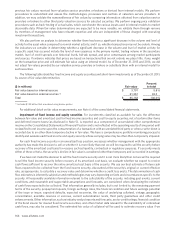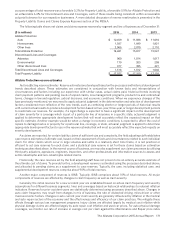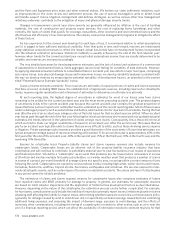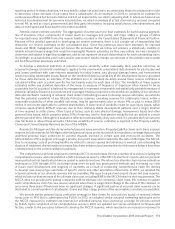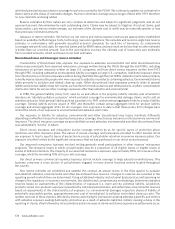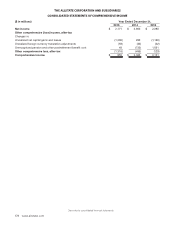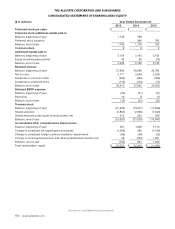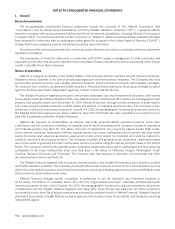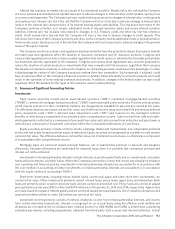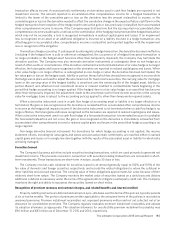Allstate 2015 Annual Report Download - page 182
Download and view the complete annual report
Please find page 182 of the 2015 Allstate annual report below. You can navigate through the pages in the report by either clicking on the pages listed below, or by using the keyword search tool below to find specific information within the annual report.176 www.allstate.com
Further discussion of reserve estimates For further discussion of these estimates and quantification of the impact of
reserve estimates, reserve reestimates and assumptions, see Notes 8 and 14 to the consolidated financial statements
and the Property-Liability Claims and Claims Expense Reserves section of the MD&A.
Reserve for life-contingent contract benefits estimation Due to the long term nature of traditional life insurance,
life-contingent immediate annuities and voluntary accident and health insurance products, benefits are payable over many
years; accordingly, the reserves are calculated as the present value of future expected benefits to be paid, reduced by the
present value of future expected net premiums. Long-term actuarial assumptions of future investment yields, mortality,
morbidity, policy terminations and expenses are used when establishing the reserve for life-contingent contract benefits
payable under these insurance policies. These assumptions, which for traditional life insurance are applied using the net level
premium method, include provisions for adverse deviation and generally vary by characteristics such as type of coverage,
year of issue and policy duration. Future investment yield assumptions are determined based upon prevailing investment
yields as well as estimated reinvestment yields. Mortality, morbidity and policy termination assumptions are based on
our experience and industry experience. Expense assumptions include the estimated effects of inflation and expenses to
be incurred beyond the premium-paying period. These assumptions are established at the time the policy is issued, are
consistent with assumptions for determining DAC amortization for these policies, and are generally not changed during
the policy coverage period. However, if actual experience emerges in a manner that is significantly adverse relative to the
original assumptions, adjustments to DAC or reserves may be required resulting in a charge to earnings which could have
a material effect on our operating results and financial condition.
We periodically review the adequacy of reserves and recoverability of DAC for these policies on an aggregate basis
using actual experience. In the event actual experience is significantly adverse compared to the original assumptions
and a premium deficiency is determined to exist, any remaining unamortized DAC balance must be expensed to the
extent not recoverable and the establishment of a premium deficiency reserve may be required. In 2015, 2014 and 2013,
our reviews concluded that no premium deficiency adjustments were necessary, primarily due to projected profit from
traditional life insurance more than offsetting the projected losses in immediate annuities with life contingencies. In 2015
there was an increase in projected profit from traditional life insurance and an increase in projected losses in immediate
annuities with life contingencies. We also review these policies on an aggregate basis for circumstances where projected
profits would be recognized in early years followed by projected losses in later years. In 2015, 2014 and 2013, our reviews
concluded that there were projected profits in each year of the projection period.
We will continue to monitor the experience of our traditional life insurance and immediate annuities. In 2015, we
initiated a mortality study for our structured settlement annuities with life contingencies, which is expected to be
completed in 2016. The study thus far indicates that annuitants may be living longer and receiving benefits for a longer
period than originally estimated. The preliminary results of the study were considered in the premium deficiency and
profits followed by losses evaluations described above. We anticipate that mortality, investment and reinvestment yields,
and policy terminations are the factors that would be most likely to require premium deficiency adjustments to these
reserves or related DAC.
For further detail on the reserve for life-contingent contract benefits, see Note 9 of the consolidated financial statements.
REGULATION AND LEGAL PROCEEDINGS
We are subject to extensive regulation and we are involved in various legal and regulatory actions, all of which have
an effect on specific aspects of our business. For a detailed discussion of the legal and regulatory actions in which we are
involved, see Note 14 of the consolidated financial statements.
PENDING ACCOUNTING STANDARDS
There are several pending accounting standards that we have not implemented because the implementation date
has not yet occurred. For a discussion of these pending standards, see Note 2 of the consolidated financial statements.
The effect of implementing certain accounting standards on our financial results and financial condition is often
based in part on market conditions at the time of implementation of the standard and other factors we are unable to
determine prior to implementation. For this reason, we are sometimes unable to estimate the effect of certain pending
accounting standards until the relevant authoritative body finalizes these standards or until we implement them.


